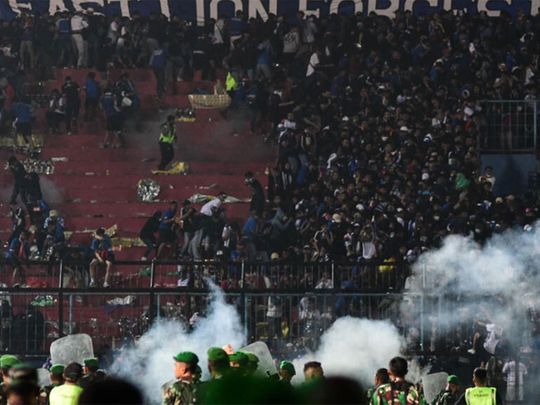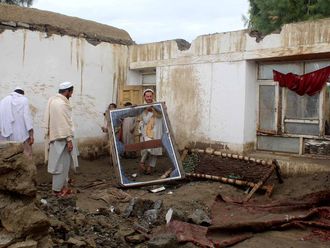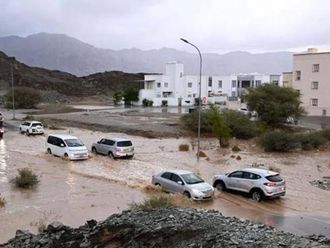
Malang, Indonesia: Anger against police mounted in Indonesia on Monday after at least 125 people were killed in one of the deadliest disasters in the history of football, when officers fired tear gas in a packed stadium, triggering a stampede.
The tragedy on Saturday night in the city of Malang also saw 323 people injured.
The incident unfolded when fans of home team Arema FC stormed the pitch at the Kanjuruhan stadium after their loss 3-2 to bitter rivals Persebaya Surabaya.
Tear gas
Police responded by launching volleys of tear gas into packed terraces, prompting spectators to rush en masse to small gates where many were trampled or suffocated, according to witnesses.
Police described the incident as a riot in which two officers were killed but survivors accuse them of overreacting and causing the deaths of scores of spectators, including a five-year-old boy.
"One of our messages is for the authorities to investigate this (incident) thoroughly. And we want accountability, who is to blame?" said 25-year-old Andika, who declined to give his last name.
"We want justice for our fallen supporters," he said.
Vigil
Outside the Kanjuruhan stadium on Sunday evening, people held a vigil beneath the roaring lion statue -- the club's symbol -- to honour the victims.
But fresh graffiti daubed on the walls of the stadium revealed bubbling anger towards the authorities.
"My siblings were killed. Investigate thoroughly," read one message scrawled on the stadium's shutters, accompanied by a black ribbon and the date of the tragedy.
In Jakarta, hundreds of football fans gathered outside the country's biggest stadium in Jakarta late Sunday chanting, singing songs in support of Arema FC and placing police tape on the complex's fence.
Indonesian President Joko Widodo announced a probe into the incident, but rights groups said it should be independent and officers should be held accountable for using tear gas in a confined area.
"We call on authorities to conduct a swift, thorough, and independent investigation into the use of tear gas at the stadium and ensure that those who are found to have committed violations are tried in open court," Amnesty International said in a statement. "This loss of life cannot go unanswered."
What happened, death toll, and reaction
The weekend incident erupted when a soccer match between two teams that were fierce rivals ended in a stampede, marking one of the world's worst stadium disasters in recent decades.
The incident in East Java province has sparked outrage and grief in Indonesia, where sports commentators and activists have slammed what they see as an excessive use of force by police, and authorities have pledged to investigate.
Questions are being asked about locked gates at the stadium, which was packed well over capacity, and about holding a match that local football experts had identified as 'high risk' due to the bitter rivalry between the two teams.
What happened at the match
The match between the home team Arema FC and Persebaya Surabaya ended with the former losing 3-2, a huge upset given that Arema had not lost a home game to Persebaya in 23 years, according to police and a local soccer expert.
The outcome angered many in the crowd, which consisted almost entirely of Arema supporters after the police had banned Persebaya supporters from attending for fear of violent clashes.
Agitated Arema FC fans streamed onto the pitch after the match to vent their frustration, prompting clashes with police, who fired tear gas to try and disperse them.
The tear gas sent waves of panic through the crowds, with many caught up in a deadly crush as they tried to escape.
Authorities say 125 people were killed, including 32 minors.
Why was the death toll so high
The severity of the stadium disaster was due to a confluence of factors, including a venue packed beyond capacity, poor safety planning, and a lack of communication among organisers and police.
While the stadium in Malang has several exit gates, spectators told Reuters that some of these were locked during Saturday's match, causing bottlenecks and chaos as fans tried to flee. Medics said some of the victims died of suffocation, while others suffered head injuries.
Police at the stadium are also facing scrutiny for using tear gas, banned by world soccer governing body, FIFA. Police in Indonesia occasionally use tear gas to disperse street demonstrations but tend not to do so at sporting events.
How does it compare with other sporting disasters?
Indonesia has a history of violence and football hooliganism, especially in major urban centres such as Jakarta, but the scale of this incident is unprecedented, ranking among the worst globally in recent decades.
In 1964, 328 people were killed when Peru hosted Argentina at the Estadio Nacional in Lima, while in the late 1980s, 96 Liverpool supporters were crushed to death when an overcrowded and fenced-in enclosure collapsed at the Hillsborough Stadium in Sheffield.
What happens next?
Indonesia's chief security minister Mahfud MD has formed an independent fact-finding team to investigate the stampede, while President Joko Widodo has ordered the country's football association to suspend all games in the top league, known as Liga 1.
FIFA has requested a report on the incident, which it described as a "dark day for all involved".
The government will provide 50 million rupiah ($3,268) in compensation to each of the victims' families, while hundreds more who were injured will be treated for free.
There are also growing calls for the police and football organisations to formulate ways to work more closely to prevent similar disasters in future.












